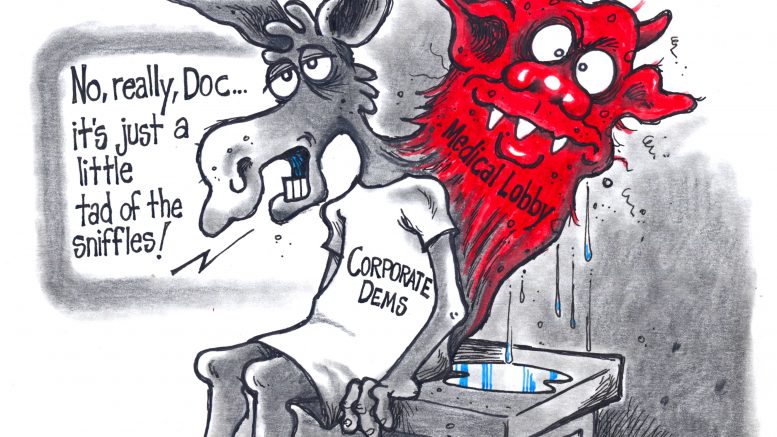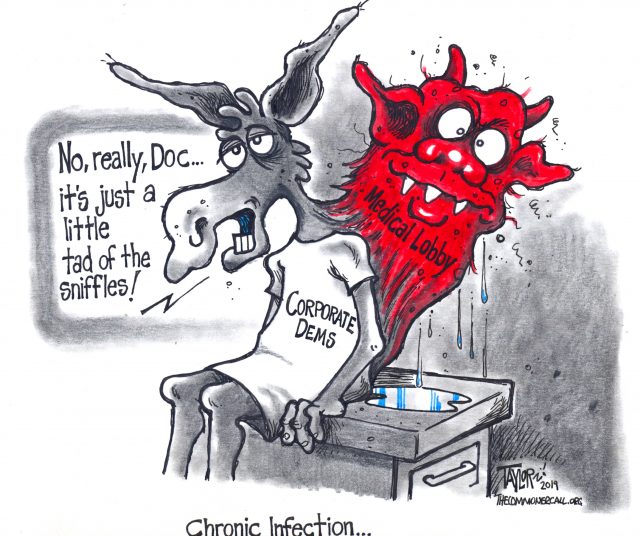How health insurance cash creates misinformation on Medicare For All.
[Editor’ Note: For godsake, don’t waste a tarnished penny on the DCCC. Find and support positive progressive candidates and groups, especially those taking on infected corporate dems like Rep. Cheri Bustos or, closer to home, Rep. Ron Kind, and, of course anyone running against republicans. — Mark L. Taylor]
By Wendell Potter
Tarbell (3/15/19)
Here’s a headline you can bet my former colleagues in the health insurance business were thrilled to see last week: “DCCC chief: Medicare for All price tag ‘a little scary.’”
That headline topped the lead story in the March 6 edition of The Hill, a newspaper widely read by Congressional staff and lobbyists and others in the influence-peddling business in Washington. You’ll see ads in The Hill by big corporations and special interests you won’t see anywhere else—like the full-page “we’re-not-a-bad-guy” ad on page 2 by opioid maker Purdue Pharma and the two full-page “we’re-part-of the-solution” ads a bit deeper inside by Eli Lilly.
The DCCC—for those of us outside the Beltway—stands for the Democratic Congressional Campaign Committee, the organization responsible for hauling in as much cash as possible for Democratic candidates running for Congress. And the new “d-triple-c” chief—Rep. Cheri Bustos of Illinois—is a real pro when it comes to shaking down special interests, health insurers in particular, for the Dems.
Most of Bustos’ campaign cash last year came from people who couldn’t even vote for her. Nearly 80 percent came from outside of her district and more than half from out of state. None of the big five for-profit insurers that wrote big checks to her campaign are based in Illinois.
I mentioned Bustos in a story I wrote on June 25, the day before Alexandria Ocasio-Cortez stunned party honchos with her upset victory over longtime incumbent Joe Crowley in the New York Democratic primary. Crowley, as I pointed out, was one of a handful of House Democrats who received campaign contributions from the political action committees of all five of the biggest for-profit health insurers—Aetna, Anthem, Cigna, Humana and UnitedHealth Group. But Crowley wasn’t those PACs’ favorite Democrat in Congress. That distinction at the time went to none other than Cheri Bustos.
Big bucket of ice-cold water
So it came as no surprise to see Bustos pouring a big bucket of ice-cold water on the very idea that Congress would give serious consideration to improving and expanding the Medicare program to cover every American, which polls show a big majority of Democratic voters—and even a sizable percentage of Republican voters—favor. When Medicare covers all of us, there will be no need for health insurers as we know them—and we know them increasingly as barriers to getting the care we need. To delay for as long as possible the day Medicare covers everybody, the insurance industry and its allies are showering Democrats with campaign cash and providing their friends in high places—including Cheri Bustos—with talking points designed to scare the daylights out of people.
Bustos and I have a lot in common. We both were journalists in our first career: She was a reporter for the Quad City Times in Davenport, Iowa; I was a reporter for Scripps-Howard newspapers in Tennessee and Washington. She left journalism to go work for a big hospital system in Iowa; I went to work for a big hospital system in Tennessee (and from there to Humana and Cigna). She and I even had the same title at the end of our corporate careers—Vice President of Corporate Communications—and we both were paid handsomely. The Quad City Times reported that Bustos was making north of $300,000 when she quit to run for Congress. She took a sizable pay cut when she was sworn into office to represent Illinois’ 17th congressional district in 2013. I took an even deeper pay cut when I left my corporate job and blew the whistle on my former employers. I have written about politicians on the take; she is one of those politicians.
Lots of money for Cheri
Bustos was a proven fundraiser from the start. Since 2011, when she launched her first campaign, she has raised nearly $13 million, according to the Center for Responsive Politics. Even though she was widely favored to win reelection last year (she beat her Republican opponent by more than 24 points), she still raised $4.5 million, much of which she didn’t need or spend. That big pile of Benjamins was considerably more than the average raised by other House members.
And there’s this: Nearly 85 percent of what her campaign took in came from corporate and special interest PACs and large individual contributions. Less than 13 percent came from small individual contributions.
Most of Bustos’ campaign cash last year came from people who couldn’t even vote for her. Nearly 80 percent came from outside of her district and more than half from out of state. None of the big five for-profit insurers that wrote big checks to her campaign are based in Illinois.
Bustos’ comments in the Hill story came a week after Rep. Pramila Jayapal (D-Washington) introduced The Medicare for All Act of 2019 with 107 cosponsors, and they tracked with talking points now flooding Washington by the health care industry’s new front group, the Partnership for America’s Health Care Future, which comprises health insurers, drug companies and big hospital systems like the one Bustos used to work for. It was created for the explicit purpose of scaring Democrats away from any Medicare for All legislation.
“What do we have—130 million-something Americans who get their health insurance through their work?” Bustos was quoted as saying in the Hill article. “The transition from what we have now to Medicare for all, it’s just hard to conceive how that would work. You have so many jobs attached to the health care industry. I think the $33 trillion price tag for Medicare for all is a little scary.”
Corporate dems & Koch brothers
Now compare that to the messaging in the Partnership’s first digital ad last month attacking Medicare for All proposals. And note, too, that that “scary” $33 trillion figure—which, by the way, covers a ten-year-period—came from a study produced by a think tank funded by the Koch Brothers, two rich guys no one would mistake for Democrats. What Bustos didn’t mention is that even that study, biased as it was, concluded that sticking with our current private insurance driven-system would cost $2 trillion more than Medicare for All. Bottom line: Medicare for All would be a bargain compared to the status quo Bustos, who thrives in the swamp that is Washington, is defending.
Bustos clearly is one of the health care industry’s reliable go-to Democrats on Capitol Hill. She’s not the only one, though, not by a long shot. In the coming days, Tarbell will be publishing a comprehensive analysis of Congressional Democrats on the take from health care special interests. Watch this space.


